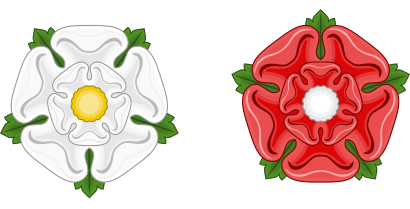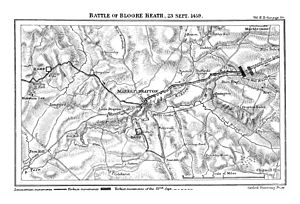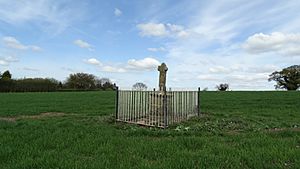Battle of Blore Heath facts for kids
Quick facts for kids Battle of Blore Heath |
|||||||
|---|---|---|---|---|---|---|---|
| Part of the Wars of the Roses | |||||||
 |
|||||||
|
|||||||
| Belligerents | |||||||
| Commanders and leaders | |||||||
| Strength | |||||||
| 5,000 | 10,000 | ||||||
| Casualties and losses | |||||||
| 1,000 | 2,000 | ||||||
The Battle of Blore Heath was an important fight in the Wars of the Roses. This was a series of wars fought in England between two powerful families, the House of York (who used a white rose as their symbol) and the House of Lancaster (who used a red rose). The battle happened on September 23, 1459, at a place called Blore Heath in Staffordshire, England. Blore Heath is a quiet farming area near the towns of Market Drayton and Loggerheads, Staffordshire.
Contents
Why the Battle Happened
After an earlier battle in 1455, there was a shaky peace in England. The two main families, Lancaster and York, tried to get along, but it didn't work very well. By 1459, both sides were gathering their armies again.
Queen Margaret of Anjou was raising support for King Henry VI (from the House of Lancaster). She gave a silver swan badge to her supporters. Meanwhile, the Duke of York (from the House of York) was also finding many people who didn't support the king.
The Yorkist army, led by the Earl of Salisbury, was in Yorkshire. They needed to join up with the main Yorkist army in Shropshire. As Salisbury marched south, the Queen ordered Lord Audley to stop him.
The Battle Begins
Lord Audley chose Blore Heath for his ambush. It was a good spot because it was open land. On the morning of September 23, 1459, Audley's army of about 10,000 men hid behind a large hedge. They were waiting for Salisbury's army to arrive.
Yorkist scouts saw the Lancastrian flags over the hedge. They quickly warned Salisbury. His army of about 5,000 men realized they were walking into a trap. Salisbury didn't run away. Instead, he quickly got his soldiers ready for battle.
He placed his supply wagons in a circle to protect his right side. This gave his men cover. Some Yorkist soldiers were so scared they kissed the ground. They thought they would die there.
The two armies were about 300 meters apart. A wide, fast-flowing stream ran between them. This stream made Audley's position very strong. It seemed impossible to attack him.
Fighting at Blore Heath
At first, both leaders tried to talk to each other to avoid fighting. But they couldn't agree. The battle started with archers shooting arrows. Both sides had longbows. But the armies were too far apart for the arrows to do much damage.
Salisbury knew it would be a disaster to attack across the stream. So, he came up with a clever trick. He made some of his soldiers pretend to retreat. They moved back just enough so the Lancastrians thought they were running away.
The Lancastrians fell for the trick. They launched a cavalry charge, rushing forward. Once they were committed, Salisbury ordered his men to turn around. They caught the Lancastrians as they tried to cross the stream. This attack caused many Lancastrian soldiers to be killed.
The Lancastrians pulled back. Then they attacked again, perhaps trying to save their wounded. This second attack was more successful. Many Lancastrians managed to cross the stream. This led to very fierce fighting. Lord Audley himself was killed during this time.
After Audley died, Lord Dudley took command of the Lancastrian army. He ordered an attack on foot with about 4,000 men. But this attack also failed. About 500 Lancastrian soldiers then switched sides. They started fighting against their own army.
At this point, the remaining Lancastrian resistance completely broke down. The Yorkists just had to push forward to win. The Yorkists chased the fleeing Lancastrians for miles.
About 2,000 Lancastrians were killed. The Yorkists lost almost 1,000 men.
What Happened Next
Salisbury was worried that more Lancastrian soldiers were nearby. He wanted to keep moving south towards Ludlow. He set up his camp on a hill near Market Drayton. This hill is now called Salisbury Hill.
To trick any nearby Lancastrians, Salisbury had a local friar stay on Blore Heath all night. The friar fired a cannon from time to time. This made it sound like the battle was still going on.
Lord Audley was buried in Darley Abbey in Derbyshire.
Remembering the Battle
After the battle, a cross was put up at Blore Heath. It marked the spot where Lord Audley was killed. A stone cross replaced it in 1765.
Until 2009, the battle was remembered each September. People would re-enact the Battle of Blore Heath.
See also
 In Spanish: Batalla de Blore Heath para niños
In Spanish: Batalla de Blore Heath para niños





